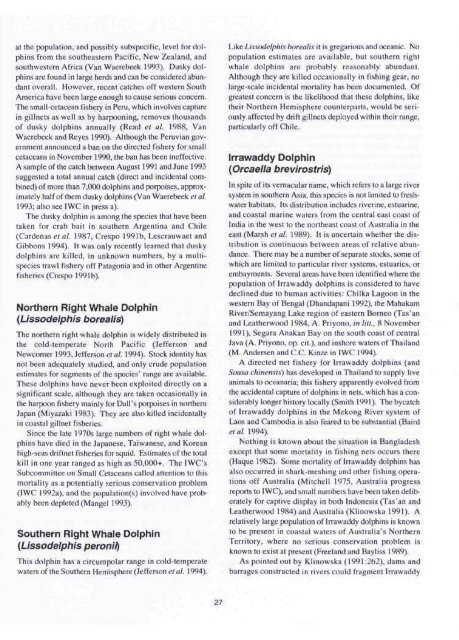Dolphins, Porpoises, and Whales - IUCN
Dolphins, Porpoises, and Whales - IUCN
Dolphins, Porpoises, and Whales - IUCN
Create successful ePaper yourself
Turn your PDF publications into a flip-book with our unique Google optimized e-Paper software.
at the population, <strong>and</strong> possibly subspecific, level for dolphins<br />
from the southeastern Pacific, New Zeal<strong>and</strong>, <strong>and</strong><br />
southwestern Africa (Van Waerebeek 1993). Dusky dolphins<br />
are found in large herds <strong>and</strong> can be considered abundant<br />
overall. However, recent catches off western South<br />
America have been large enough to cause serious concern.<br />
The small-cetacean fishery in Peru, which involves capture<br />
in gillnets as well as by harpooning, removes thous<strong>and</strong>s<br />
of dusky dolphins annually (Read et al. 1988, Van<br />
Waerebeek <strong>and</strong> Reyes 1990). Although the Peruvian government<br />
announced a ban on the directed fishery for small<br />
cetaceans in November 1990, the ban has been ineffective.<br />
A sample of the catch between August 1991 <strong>and</strong> June 1993<br />
suggested a total annual catch (direct <strong>and</strong> incidental combined)<br />
of more than 7,000 dolphins <strong>and</strong> porpoises, approximately<br />
half of them dusky dolphins (Van Waerebeek elal.<br />
1993; also see IWC in press a).<br />
The dusky dolphin is among the species that have been<br />
taken for crab bait in southern Argentina <strong>and</strong> Chile<br />
(Cardenas et al. 1987, Crespo 1991b, Lescrauwaet <strong>and</strong><br />
Gibbons 1994). It was only recently learned that dusky<br />
dolphins are killed, in unknown numbers, by a multispecies<br />
trawl fishery off Patagonia <strong>and</strong> in other Argentine<br />
fisheries (Crespo 1991b).<br />
Northern Right Whale Dolphin<br />
{Lissodelphis borealis)<br />
The northern right whale dolphin is widely distributed in<br />
the cold-temperate North Pacific (Jefferson <strong>and</strong><br />
Newcomer 1993, Jefferson e< a/. 1994). Stock identity has<br />
not been adequately studied, <strong>and</strong> only crude population<br />
estimates for segments of the species' range are available.<br />
These dolphins have never been exploited directly on a<br />
significant scale, although they are taken occasionally in<br />
the harpoon fishery mainly for Dall's porpoises in northern<br />
Japan (Miyazaki 1983). They are also killed incidentally<br />
in coastal gillnet fisheries.<br />
Since the late 1970s large numbers of right whale dolphins<br />
have died in the Japanese, Taiwanese, <strong>and</strong> Korean<br />
high-seas driftnet fisheries for squid. Estimates of the total<br />
kill in one year ranged as high as 50,000+. The IWC's<br />
Subcommittee on Small Cetaceans called attention to this<br />
mortality as a potentially serious conservation problem<br />
(IWC 1992a), <strong>and</strong> the population(s) involved have probably<br />
been depleted (Mangel 1993).<br />
Southern Right Whale Dolphin<br />
{Lissodelphis peronii)<br />
This dolphin has a circumpolar range in cold-temperate<br />
waters of the Southern Hemisphere (Jefferson et al. 1994).<br />
Sf'<br />
Like Lissodelphis borealis it is gregarious <strong>and</strong> oceanic. No<br />
population estimates are available, but southern right<br />
whale dolphins are probably reasonably abundant.<br />
Although they are killed occasionally in fishing gear, no<br />
large-scale incidental mortality has been documented. Of<br />
greatest concern is the likelihood that these dolphins, like<br />
their Northern Hemisphere counterparts, would be seriously<br />
affected by drift gillnets deployed within their range,<br />
particularly off Chile.<br />
Irrawaddy Dolphin<br />
{Orcaella brevirostris)<br />
In spite of its vernacular name, which refers to a large river<br />
system in southern Asia, this species is not limited to freshwater<br />
habitats. Its distribution includes riverine, estuarine,<br />
<strong>and</strong> coastal marine waters from the central east coast of<br />
India in the west to the northeast coast of Australia in the<br />
east (Marsh et al. 1989). It is uncertain whether the distribution<br />
is continuous between areas of relative abundance.<br />
There may be a number of separate stocks, some of<br />
which are limited to particular river systems, estuaries, or<br />
embayments. Several areas have been identified where the<br />
population of Irrawaddy dolphins is considered to have<br />
declined due to human activities: Chilka Lagoon in the<br />
western Bay of Bengal (Dh<strong>and</strong>apani 1992), the Mahakam<br />
River/Semayang Lake region of eastern Borneo (Tas'an<br />
<strong>and</strong> Leatherwood 1984, A. Priyono, in litt., 8 November<br />
1991), Segara Anakan Bay on the south coast of central<br />
Java (A. Priyono, op. cit.), <strong>and</strong> inshore waters of Thail<strong>and</strong><br />
(M. Andersen <strong>and</strong> C.C. Kinze in IWC 1994).<br />
A directed net fishery for Irrawaddy dolphins (<strong>and</strong><br />
Sousa chinensis) has developed in Thail<strong>and</strong> to supply live<br />
animals to oceanaria; this fishery apparently evolved from<br />
the accidental capture of dolphins in nets, which has a considerably<br />
longer history locally (Smith 1991). The bycatch<br />
of Irrawaddy dolphins in the Mekong River system of<br />
Laos <strong>and</strong> Cambodia is also feared to be substantial (Baird<br />
etal. 1994).<br />
Nothing is known about the situation in Bangladesh<br />
except that some mortality in fishing nets occurs there<br />
(Haque 1982). Some mortality of Irrawaddy dolphins has<br />
also occurred in shark-meshing <strong>and</strong> other fishing operations<br />
off Australia (Mitchell 1975, Australia progress<br />
reports to IWC), <strong>and</strong> small numbers have been taken deliberately<br />
for captive display in both Indonesia (Tas'an <strong>and</strong><br />
Leatherwood 1984) <strong>and</strong> Australia (Klinowska 1991). A<br />
relatively large population of Irrawaddy dolphins is known<br />
to be present in coastal waters of Australia's Northern<br />
Territory, where no serious conservation problem is<br />
known to exist at present (Freel<strong>and</strong> <strong>and</strong> Bayliss 1989).<br />
As pointed out by Klinowska (1991:262), dams <strong>and</strong><br />
barrages constructed in rivers could fragment Irrawaddy

















